In the 1990s, marketers proved that just about anything can be bottled and sold by convincing us to buy water. Since then, we've bought more and more of it. Bottled water consumption has quadrupled since 1990. The marketing feat of the decade relied on positioning the product as a kind of status hydration. Some people are content slurping straight from the tap for less than a penny a glass. Set yourself apart by paying up for natural artesian water bottled from the islands of Fiji.
In recent years, bottled water's sophisticated status has given way to less palatable connotations—global warming, plastic pollution, disposable consumer culture. We know now that bottled water has about 1,000 times the carbon footprint of plain old tap water. As choosy drinkers begin to view environmental consciousness as a key status indicator, clever marketers have found an alternative strategy for classing up water: Make it sparkle.
Enter the home carbonator. Gadgets like SodaStream, iSi’s Soda Siphon, and Twist n’ Sparkle, which allow drinkers to dress up tap water within the confines of their own homes, are claiming precious countertop space in kitchens across the country. Further afield, cities across Europe and restaurants across America are infusing municipal tap water with a throat-ripping cachet of carbonation. The process has even caught on with some jerks in Brooklyn hoping to resurrect the old-timey charm of phosphates and drugstore soda fountains.
Rick Agresta, president and CEO at iSi North America, says several factors are driving the bubbly tap water trend. “It costs less money. You can control the calorie content and the ingredients when you make it yourself," Agresta told me. "There’s also a craft element," he says. "It's the satisfaction of drinking something that you made.”
Taking control of the production process also allows consumers to keep a handle on water's ecological effects. Homemade carbonators discard the need for the gas-guzzling trucks that heft heavy water bottles from far-away springs, as well as the disposable plastic packages that deliver the water straight to your lips. That leaves home sparklers with one big environmental mystery: Every couple of months, they must secure a new carbonator filled with carbon dioxide. That's the same compound that's pumping out of your cross-town bus's exhaust pipe and it's a major contributor to global warming. Where does all that gas come from?
Centuries ago, that question had a simple answer. Water brimming with tiny bubbles came exclusively from insthe earth. In 218 BC, according to a legend perpetuated by Perrier, Hannibal discovered an effervescent spring in Vergèze after a trip across the Alps. Hannibal was pretty refreshed by the water and its dissolved carbon dioxide gasses, and, so, apparently, was his elephant. As it turns out, we're not the first humans to link water sources with self-worth. In the centuries that followed, Europeans associated soaking and drinking naturally carbonated mineral spring waters with health, and sparkling waters began turning up on pharmacy shelves.
That process persisted until 1772, when an English chemist named Joseph Priestly set out to replicate the “fixed air” in the mineral waters of Germany’s “Vapor Cave," believing that it could cure scurvy. Priestly's theory didn't hold water, but he nevertheless found that by dripping a little “oil of vitriol”—or sulfuric acid—into a container with chalk and water, he could create and capture CO2 in the lab. By the late 19th century, carbonators made their way behind drugstore counters, and two of the most well-known American pharmacists, Caleb Bradham and John Pemberton, doctored up carbonated water to make Pepsi and Coca-Cola.
Today, the carbon dioxide in bottled and homemade sparkling waters is predominantly manufactured. Only water labeled “Sparkling Bottled Water” was actually tapped from the source with bubbles intact. Under the Food and Drug Administration's confusing labeling rules, that term can apply to water that's been manually carbonated, too, as long as the water is sold with "the same amount of carbon dioxide that it had at emergence from the source." In the case of Italy’s San Pellegrino, The Big Thirst author Charles Fishman told me, the company actually extracts naturally occurring carbon dioxide from water at one of its wells and then adds that gas back in to water extracted from another well.
Aside from these and other natural wells of carbon dioxide inside the earth, the gas used for carbonation is often cultivated from waste.
Susan Szita Gore, a Praxair spokeswoman, told me that their gas is captured from the biproduct of other industrial processes. “When you make ammonia, those plants will emit carbon dioxide. Most of the time, it’s just vented to the air. Coal-burning electric plants will emit carbon dioxide," Gore says. "So what we do is capture the CO2 from an industrial process, purify it, chill it, and deliver it. It’s almost a form of recycling.”
While there's some carbon offset from capturing and cleaning the waste gases produced by fermenting ethanol or ammonia, infusing your tap with bubbles won't exactly save the world. The 2.2 grams of CO2 contained in a 16 ounce drink remains pretty inconsequential compared to the carbon dioxide released during the production and delivery of the gas straight to your kitchen. Hey, at least it beats Fiji.
Images viaDescriptive Catalogue of James W. Tufts Arctic Soda Water Apparatus, 1890, courtesy of Rabelais Books. Thumbnail photo (cc) via Flickr user racheocity













